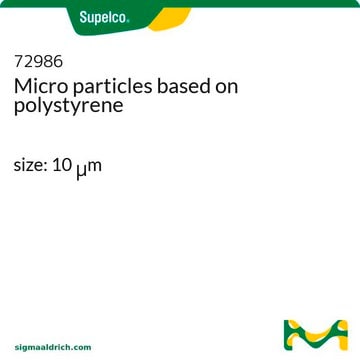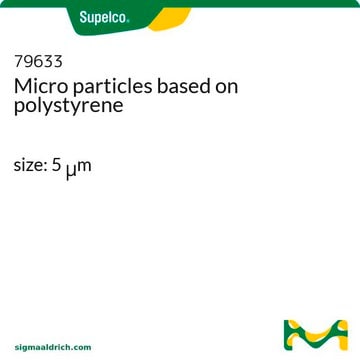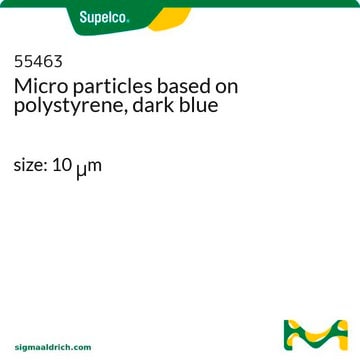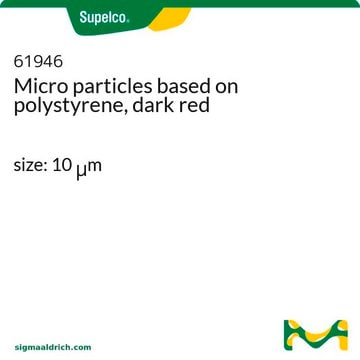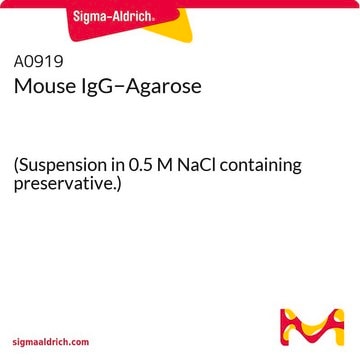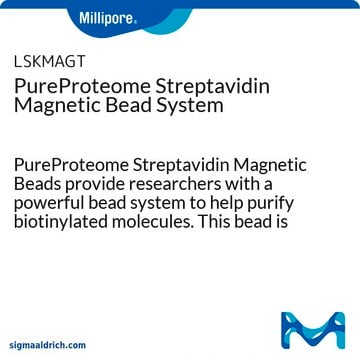49664
Micro particles based on polystyrene, magnetic
10 μm particle size, std dev <0.5 μm
Synonym(s):
Latex beads from PS, magnetic
Sign Into View Organizational & Contract Pricing
All Photos(1)
About This Item
UNSPSC Code:
12352207
NACRES:
NA.54
Recommended Products
form
aqueous solution
composition
iron oxide, ≥20%
concentration
5% solids
particle size
10 μm std dev <0.5 μm
storage temp.
2-8°C
Looking for similar products? Visit Product Comparison Guide
Related Categories
General description
Superparamagnetic nanoparticles embedded in polystyrene microspheres (magnetic beads) play a vital role in cell separation and labeling. In addition, it is also used in various biomedical and bioengineering applications such as magnetic resonance imaging contrast enhancement, tissue repair, immunoassay, detoxification of biological fluids, hyperthermia, and drug delivery.
Magnetic polystyrene particles
Application
Micro particles based on polystyrene, magnetic has been used as magnetic biofilm carriers to separate and re-introduce microorganisms in a continuously stirred tank reactors (CSTR). It has also been used in magnetic microrheometry for measuring the cell-size-scale viscoelastic properties of stiffer 3D cell-culture matrices by micromanipulator experiments.
Storage Class Code
12 - Non Combustible Liquids
WGK
nwg
Flash Point(F)
Not applicable
Flash Point(C)
Not applicable
Personal Protective Equipment
dust mask type N95 (US), Eyeshields, Gloves
Certificates of Analysis (COA)
Search for Certificates of Analysis (COA) by entering the products Lot/Batch Number. Lot and Batch Numbers can be found on a product’s label following the words ‘Lot’ or ‘Batch’.
Already Own This Product?
Find documentation for the products that you have recently purchased in the Document Library.
Customers Also Viewed
Erdal C Oğuz et al.
Physical review letters, 124(23), 238003-238003 (2020-07-01)
Recovery of ground-state degeneracy in two-dimensional square ice is a significant challenge in the field of geometric frustration with far-reaching fundamental implications, such as realization of vertex models and understanding the effect of dimensionality reduction. We combine experiments, theory, and
Juho Pokki et al.
Biomedical microdevices, 23(2), 27-27 (2021-04-27)
Changes in extracellular matrix stiffness impact a variety of biological processes including cancer progression. However, cells also actively remodel the matrices they interact with, dynamically altering the matrix mechanics they respond to. Further, cells not only react to matrix stiffness
Yau Kei Chan et al.
ACS applied materials & interfaces, 11(25), 22869-22877 (2019-05-31)
Cells in vitro usually require a solid scaffold to attach and form two-dimensional monolayer structures. To obtain a substrate-free cell monolayer, long culture time and specific detaching procedures are required. In this study, a thin-film-flow-induced strategy is reported to overcome
Our team of scientists has experience in all areas of research including Life Science, Material Science, Chemical Synthesis, Chromatography, Analytical and many others.
Contact Technical Service